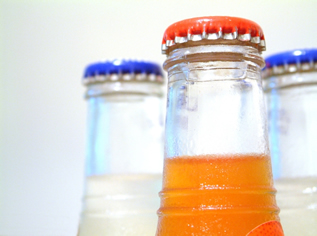Beverage Bottling

 Beverage
bottling typically starts with water being treated and cleansed
to meet exacting quality-control standards, usually exceeding
the quality of the local water supply. For beverage bottling
it is critical to maintain a high quality of water, this will
ensure consistent taste profiles in the finished products. The
treated water is piped into stainless-steel tanks of different
sizes, each one to be utilized at different stages of the beverage
bottling process. Beverage
bottling typically starts with water being treated and cleansed
to meet exacting quality-control standards, usually exceeding
the quality of the local water supply. For beverage bottling
it is critical to maintain a high quality of water, this will
ensure consistent taste profiles in the finished products. The
treated water is piped into stainless-steel tanks of different
sizes, each one to be utilized at different stages of the beverage
bottling process.
In the next stage of beverage bottling various ingredients
are added and mixed in batching tanks, these are smaller holding
tanks used during beverage bottling to make syrup.
The syrup
can include ingredients such as liquid sugars like fructose or
sucrose, non-nutritive sweeteners such as aspartame or saccharin,
color, flavors, nutraceuticals, preservatives as well as a host
of other ingredient options. Once the syrup is ready it is pumped
into much larger tanks where it is mixed with more water to create
a finished solution ready for beverage bottling.
If the beverage bottling process is going to be for a carbonated
(absorption of carbon dioxide (CO2)) product the solution is
cooled using large, ammonia-based refrigeration systems. Carbonation
is what gives carbonated products their effervescence and texture.
CO2 that is going to be used for beverage bottling is stored
in a liquid state and piped into carbonation units as needed.
This process can be manipulated during the beverage bottling
process to control the required rate of C02 absorption into the
product. Beverages may contain from 15 to 75 psi of CO2. Fruit-flavored
soft drinks tend to have less carbonation than colas or sparkling
water. Once carbonated, the beverage is ready to be bottled.
The filling room usually is separated from the rest of the facility,
protecting open product from any possible contaminants that may
occur during beverage bottling. This highly automated beverage
bottling operation requires a minimal number of personnel. Filling
room operators monitor the equipment for efficiency, adding any
components that are needed during the beverage bottling process.
Empty beverage bottles are transported automatically to the filling
machine via bulk material-handling equipment.
Once all of the beverage bottles are filled they are automatically
packed into trays and then shrink wrapped. This finished case
of beverage bottles is then placed onto pallets by a palletizer
and wrapped with plastic wrap ready for shipping.
If you are interested in finding out more about the beverage
bottling process contact us today and let us help you start bottling
beverages.
|

